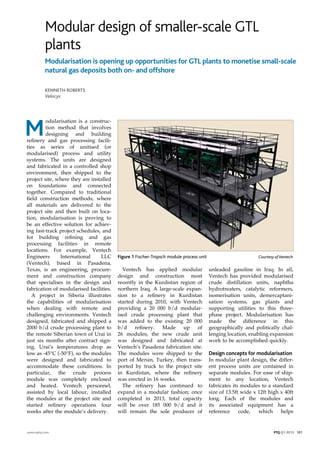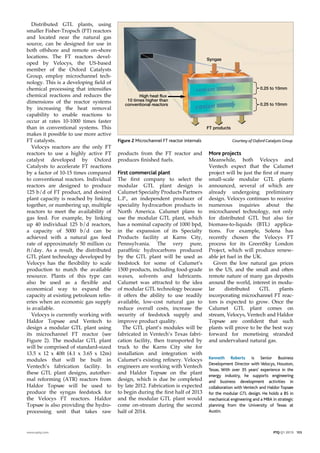Velocys PTQ_modular_design_of_GTL_130101
- 1. Modular design of smaller-scale GTL plants M odularisation is a construc- tion method that involves designing and building refinery and gas processing facili- ties as series of unitised (or modularised) process and utility systems. The units are designed and fabricated in a controlled shop environment, then shipped to the project site, where they are installed on foundations and connected together. Compared to traditional field construction methods, where all materials are delivered to the project site and then built on loca- tion, modularisation is proving to be an effective solution for achiev- ing fast-track project schedules, and for building refining and gas processing facilities in remote locations. For example, Ventech Engineers International LLC (Ventech), based in Pasadena, Texas, is an engineering, procure- ment and construction company that specialises in the design and fabrication of modularised facilities. A project in Siberia illustrates the capabilities of modularisation when dealing with remote and challenging environments. Ventech designed, fabricated and shipped a 2000 b/d crude processing plant to the remote Siberian town of Urai in just six months after contract sign- ing. Urai’s temperatures drop as low as -45°C (-50°F), so the modules were designed and fabricated to accommodate these conditions. In particular, the crude process module was completely enclosed and heated. Ventech personnel, assisted by local labour, installed the modules at the project site and started refinery operations four weeks after the module’s delivery. Modularisation is opening up opportunities for GTL plants to monetise small-scale natural gas deposits both on- and offshore Kenneth Roberts Velocys Ventech has applied modular design and construction most recently in the Kurdistan region of northern Iraq. A large-scale expan- sion to a refinery in Kurdistan started during 2010, with Ventech providing a 20 000 b/d modular- ised crude processing plant that was added to the existing 20 000 b/d refinery. Made up of 26 modules, the new crude unit was designed and fabricated at Ventech’s Pasadena fabrication site. The modules were shipped to the port of Mersin, Turkey, then trans- ported by truck to the project site in Kurdistan, where the refinery was erected in 16 weeks. The refinery has continued to expand in a modular fashion; once completed in 2013, total capacity will be over 185 000 b/d and it will remain the sole producer of unleaded gasoline in Iraq. In all, Ventech has provided modularised crude distillation units, naphtha hydrotreaters, catalytic reformers, isomerisation units, demercaptani- sation systems, gas plants and supporting utilities to this three- phase project. Modularisation has made the difference in this geographically and politically chal- lenging location, enabling expansion work to be accomplished quickly. Design concepts for modularisation In modular plant design, the differ- ent process units are contained in separate modules. For ease of ship- ment to any location, Ventech fabricates its modules to a standard size of 13.5ft wide x 12ft high x 40ft long. Each of the modules and its associated equipment has a reference code, which helps www.eptq.com PTQ Q1 2013 101 Figure 1 Fischer-Tropsch module process unit Courtesy ofVentech
- 2. 102 PTQ Q1 2013 www.eptq.com communicate where the module will be installed on the plot plan. Connections between the modules are designed to be similar in config- uration so that construction is relatively straightforward. Ventech estimates that, with modularisation, approximately 70% of a project is already complete even before the modules are shipped from their facility. This greatly decreases field construction time to deliver an operational facility (see Figure 1). These methods also facilitate easy disassembly and relocation, if necessary, at some point in the future. For example, a remotely located gas processing facility could be easily taken apart and moved to a new natural gas source if an exist- ing supply was depleted in its current location. Applying modularisation to refin- ery construction has advantages with regard to productivity, prod- uct quality and ensuring the safety of construction personnel. Since the modules are built in a well-lit, climate-controlled environment, work can continue around the clock regardless of weather conditions, for greater productivity and easier quality control. Since module height is restricted, safety is enhanced, as workers build at limited heights within the fabrication facility. Modularising GTL The same advantages of modular construction of refineries are being applied to the construction of distributed GTL plants. The GTL process involves two operations: the conversion of natural gas to a mixture of carbon monoxide (CO) and hydrogen (H2 ), known as syngas, followed by a Fischer- Tropsch (FT) process to convert the syngas into paraffinic hydrocarbons that can be further refined to produce a wide range of hydrocarbon-based products, includ- ing clean-burning, sulphur-free diesel and jet fuel. Speciality prod- ucts including food-grade waxes, solvents and lubricants can also be produced from the paraffinic hydrocarbons. Large, commercial-scale GTL plants, including the Sasol Oryx and the Shell Pearl plants (both located in Qatar), have been built at enor- mous capital cost. The Oryx plant, designed for production levels of 34 000 b/d, cost around $1.5 billion to build. The Shell Pearl plant, with an ultimate design capacity of 140 000 b/d of GTL products and 120 b/d of natural gas liquids, cost around $18-19 billion. Conventional GTL plant designs rely on econo- mies of scale to drive positive financial returns and are viable only where there are large supplies of low-priced natural gas. However, another option being developed — smaller-sized and distributed GTL plants — shows promise for deriving value from smaller accumulations of unconven- tional gas that would otherwise be left underground, such as shale gas, tight gas, coal bed methane and stranded gas (gas fields located too far from existing pipeline infra- structure). A small, modularised GTL plant has the flexibility to be installed close to the trapped resource and then used to process that resource locally. Associated gas (gas produced along with oil) is another area of opportunity for modularised GTL plants. This gas is typically disposed of either by re- injection, at considerable expense, back into the reservoir or by the wasteful and environmentally damaging practice of flaring, which is subject to increasing regulation. Modularised GTL plants enable this otherwise wasted gas to be converted into additional revenue. In the larger economic picture, a modular GTL capability can be the key factor that enables the construc- tion of upstream projects that would otherwise be cancelled because of poor results derived from economic models. For exam- ple, some shale gas discoveries are being hampered by high develop- ment costs, which result in marginal economics due to gas prices that are often low. These projects can be enhanced by converting the gas to higher-value clean fuels produced in the GTL process.
- 3. Distributed GTL plants, using smaller Fisher-Tropsch (FT) reactors and located near the natural gas source, can be designed for use in both offshore and remote on-shore locations. The FT reactors devel- oped by Velocys, the US-based member of the Oxford Catalysts Group, employ microchannel tech- nology. This is a developing field of chemical processing that intensifies chemical reactions and reduces the dimensions of the reactor systems by increasing the heat removal capability to enable reactions to occur at rates 10-1000 times faster than in conventional systems. This makes it possible to use more active FT catalysts. Velocys reactors are the only FT reactors to use a highly active FT catalyst developed by Oxford Catalysts to accelerate FT reactions by a factor of 10-15 times compared to conventional reactors. Individual reactors are designed to produce 125 b/d of FT product, and desired plant capacity is reached by linking together, or numbering up, multiple reactors to meet the availability of gas feed. For example, by linking up 40 individual 125 b/d reactors, a capacity of 5000 b/d can be achieved with a natural gas feed rate of approximately 50 million cu ft/day. As a result, the distributed GTL plant technology developed by Velocys has the flexibility to scale production to match the available resource. Plants of this type can also be used as a flexible and economical way to expand the capacity at existing petroleum refin- eries when an economic gas supply is available. Velocys is currently working with Haldor Topsøe and Ventech to design a modular GTL plant using its microchannel FT reactor (see Figure 2). The modular GTL plant will be comprised of standard-sized 13.5 x 12 x 40ft (4.1 x 3.65 x 12m) modules that will be built in Ventech’s fabrication facility. In these GTL plant designs, autother- mal reforming (ATR) reactors from Haldor Topsøe will be used to produce the syngas feedstock for the Velocys FT reactors. Haldor Topsøe is also providing the hydro- processing unit that takes raw www.eptq.com PTQ Q1 2013 103 products from the FT reactor and produces finished fuels. First commercial plant The first company to select the modular GTL plant design is Calumet Specialty Products Partners L.P., an independent producer of speciality hydrocarbon products in North America. Calumet plans to use the modular GTL plant, which has a nominal capacity of 1000 bpd, in the expansion of its Specialty Products facility at Karns City, Pennsylvania. The very pure, paraffinic hydrocarbons produced by the GTL plant will be used as feedstock for some of Calumet’s 1500 products, including food-grade waxes, solvents and lubricants. Calumet was attracted to the idea of modular GTL technology because it offers the ability to use readily available, low-cost natural gas to reduce overall costs, increase the security of feedstock supply and improve product quality. The GTL plant’s modules will be fabricated in Ventech’s Texas fabri- cation facility, then transported by truck to the Karns City site for installation and integration with Calumet’s existing refinery. Velocys engineers are working with Ventech and Haldor Topsøe on the plant design, which is due be completed by late 2012. Fabrication is expected to begin during the first half of 2013 and the modular GTL plant would come on-stream during the second half of 2014. More projects Meanwhile, both Velocys and Ventech expect that the Calumet project will be just the first of many small-scale modular GTL plants announced, several of which are already undergoing preliminary design. Velocys continues to receive numerous inquiries about the microchannel technology, not only for distributed GTL but also for biomass-to-liquids (BTL) applica- tions. For example, Solena has recently chosen the Velocys FT process for its GreenSky London Project, which will produce renew- able jet fuel in the UK. Given the low natural gas prices in the US, and the small and often remote nature of many gas deposits around the world, interest in modu- lar distributed GTL plants incorporating microchannel FT reac- tors is expected to grow. Once the Calumet GTL plant comes on stream, Velocys, Ventech and Haldor Topsøe are confident that such plants will prove to be the best way forward for monetising stranded and undervalued natural gas. Kenneth Roberts is Senior Business Development Director with Velocys, Houston, Texas. With over 35 years’ experience in the energy industry, he supports engineering and business development activities in collaboration with Ventech and Haldor Topsøe for the modular GTL design. He holds a BS in mechanical engineering and a MBA in strategic planning from the University of Texas at Austin. High heat flux 10 times higher than conventional reactors Syngas FT products 0.25 to 10mm 0.25 to 10mm Figure 2 Microchannel FT reactor internals Courtesy of Oxford Catalysts Group



